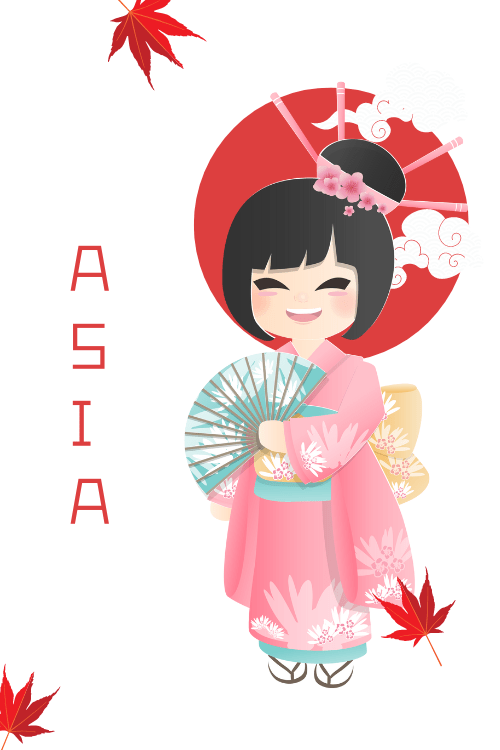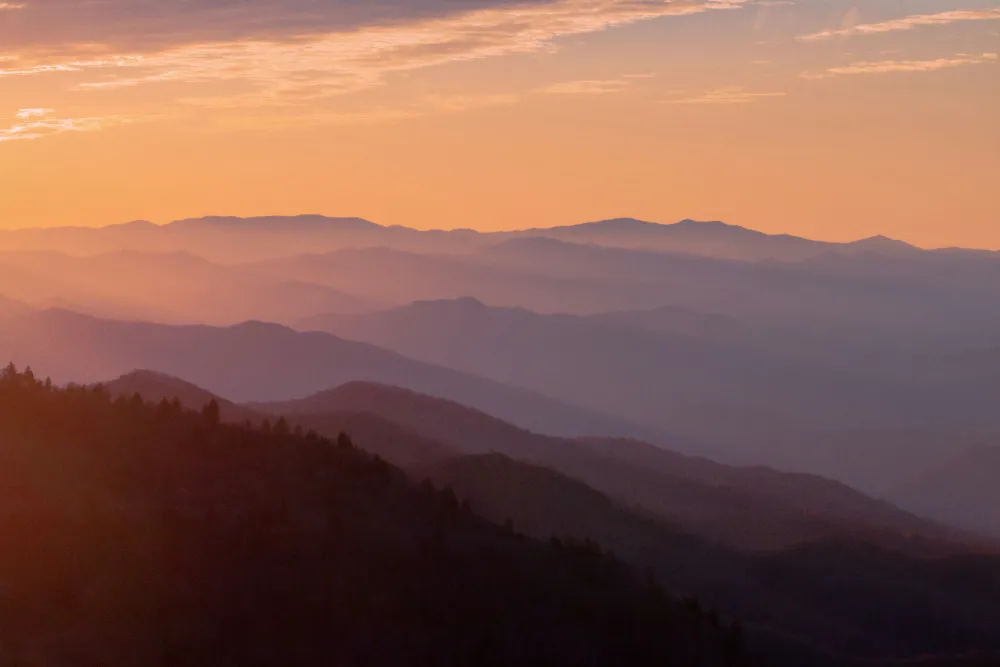eSIM USA
The Best Time to Visit the Smoky Mountains | Updated
Most guides tell you fall is best for the Smokies and leave it at that. But Great Smoky Mountains National Park transforms so dramatically across seasons that a single “best time” doesn’t exist.
The real question isn’t when to visit, it’s what you’re willing to trade. Do you want epic fall colors with bumper-to-bumper traffic?
Spring wildflowers with unpredictable weather? Summer access to everything with afternoon thunderstorms? Each season offers something distinct and comes with clear tradeoffs.
This guide uses weather data, park reports, and traveler experiences to break down exactly what each season delivers—and what it costs when planning to visit.
Crowds vs. Conditions
Your timing hinges on one central tension: the best natural conditions arrive with the worst crowds.
Peak fall foliage (mid-October) brings 100,000+ weekly visitors to a park with limited road access. You’ll spend hours in traffic to see leaves. Spring wildflowers bloom alongside unpredictable April storms. Summer delivers full facility access but daytime temperatures reaching 90°F with 80% humidity.
Winter offers near-empty trails and sweeping views through bare trees. But you’ll sacrifice facility access and deal with potential road closures.
Most visitors want to visit Great Smoky Mountains National Park during fall despite the chaos. But understanding what each season actually delivers—not just what brochures promises—reveals better options for different priorities and times of year.
What Conditions Actually Mean for Your Trip
Weather in the Smokies isn’t about comfortable temperatures. It’s about whether you can access the roads you want, see the views you came for, or hike without melting.
The park spans 5,000 feet in elevation across Tennessee and North Carolina. That creates microclimates that make general weather forecasts nearly useless. It might be 75°F in Gatlinburg while Clingmans Dome sits at 45°F with fog. Summer storms roll in most afternoons. Winter can close high-elevation roads for days because snow is a possibility.
Here’s what weather means for actual daily plans:
| Season | Valley Temp | High Elevation Temp | Rain/Snow Days | Visibility | Usable Daylight |
|---|---|---|---|---|---|
| Winter (Dec-Feb) | 30-50°F | 15-35°F | 12-15 days | Excellent (bare trees) | 9-10 hours |
| Spring (Apr-May) | 55-75°F | 40-60°F | 12-14 days | Good (some haze) | 13-14 hours |
| Summer (Jun-Aug) | 75-90°F | 60-75°F | 15-18 days | Poor (humidity haze) | 14-15 hours |
| Fall (Sep-Oct) | 50-70°F | 35-55°F | 8-10 days | Excellent | 11-12 hours |
Temperature swings matter more than averages. Bring layers for any season—you’ll use them, especially since temperatures at higher elevations can be significantly cooler.
The humidity in summer doesn’t just make you uncomfortable. It creates persistent haze that blocks the mountain views you came to see. Clear days happen, but they’re rare from June through August.
Winter’s bare trees reveal vistas that disappear behind leaves the rest of the year. That visibility advantage alone makes mid-November through February valuable for photographers and view-seekers, making it a great time for those priorities.
Stop Overpaying in Roaming Fees (Or Wasting Time Hunting for Local SIM Cards)
Overseas travel often means choosing between outrageous roaming charges or scrambling for local SIM cards the moment you land.
One drains your budget. The other steals time away from your holiday.
Smart travelers are now switching over to eSIMs.
eSIMs give you data at a fraction of the cost of what your telco charges for roaming and most modern phones have eSIM technology set up – (although you’ll need to check your phone’s compatibility here).
How eSIM4.com Works:
- Step 1: Pick your destination and data plan
- Step 2: Scan our QR code (takes 3 minutes)
- Step 3: Land overseas with instant local network access
No queues. No tiny plastic cards. No bill shock.
Just seamless, affordable data from the moment you land.
Stop letting phone companies raid your travel budget. Join the smart travelers who’ve already switched.
Get Your eSIM NowMoney and Crowds
Great Smoky Mountain National Park follows an unusual pattern—the park itself is free, but surrounding lodging costs swing wildly.
Peak fall foliage (mid-October) commands prices 3-4 times higher than January. A Gatlinburg hotel that runs $80/night in winter jumps to $300+ in October. Book six months ahead for fall weekends or accept slim pickings.
But crowds matter more than cost here because the park is one with physical bottlenecks.
| Period | Lodging Price | Weekly Visitors | Traffic Wait Times | Booking Lead Time |
|---|---|---|---|---|
| Winter (Dec-Feb) | $80-120/night | 200K-300K | Minimal | 2-4 weeks |
| Spring (Apr-May) | $120-180/night | 500K-700K | Moderate (weekends) | 6-8 weeks |
| Summer (Jun-Aug) | $150-250/night | 800K-1M | Significant (daily) | 8-12 weeks |
| Fall Peak (Oct) | $250-400/night | 1M-1.2M | Severe (all week) | 16-24 weeks |
Those visitor numbers hit a road system designed for far less traffic. The main routes through Cades Cove and to Clingmans Dome become parking lots in peak season.
October weekends can mean two-hour waits just to enter the Cades Cove Loop. You’ll spend more time in your car than on trails in the park.
Midweek visits cut wait times dramatically even in peak season. A Wednesday in October still sees crowds, but you’ll move instead of sitting in traffic for hours.
Shoulder seasons (April and May and November) offer the best crowd-to-conditions ratio. You get reasonable weather and scenery without the gridlock, and these times see fewer crowds throughout the park.
Fall (Mid-September to Early November)
Fall delivers what most people picture when they imagine the Smokies. The tradeoff is dealing with everyone else who had the same idea during this best time of year.
What the Colors Actually Look Like
Peak fall color happens in waves based on elevation. Higher elevations (above 4,000 feet) turn first, usually mid-September through early October. Lower elevations peak two to three weeks later, typically mid-October through early November.
The “peak week” everyone targets is October 15-22. That week sees the most intense autumn colors across the broadest elevation range. It’s also when the park becomes functionally unmanageable for casual visitors.
Fall foliage varies by year based on rainfall and temperature patterns. A dry September means muted colors. Warm fall days delay peak color by a week or more. Check the park’s foliage prediction map starting in September—it updates weekly.
Here’s what timing means for your experience:
| Period | Elevation Range at Peak | Crowd Level | Best For |
|---|---|---|---|
| Mid-Sep to Early Oct | 4,000-6,000 ft | Moderate | Early birds, high-elevation drives |
| Oct 10-25 | 2,000-5,000 ft | Severe | Those who planned 6+ months ahead |
| Late Oct to Early Nov | Below 2,500 ft | Moderate to Heavy | Valley views, post-peak savings |
Drive Newfound Gap Road early October for high-elevation colors. Hit Cades Cove and lower trails late October for valley foliage when exploring areas of the park.
The Hiking Window
Cool nights and crisp fall temperatures make autumn ideal for serious hiking. Daytime temperatures in the 60s and 70s, low humidity, and clear skies create perfect conditions for long trails in the park, making it perfect for hiking.
Popular routes like Alum Cave Trail and Rainbow Falls become clogged by mid-morning in October. Start at sunrise or switch to less-trafficked options like Porters Creek Trail or Big Creek area trails.
Higher elevations can see frost by late September. Clingmans Dome area trails might hit freezing at sunrise while valley trails stay comfortable. Pack layers even for shorter hikes.
Afternoon conditions stay stable in fall—unlike summer’s guaranteed thunderstorms. You can plan full-day hikes without worrying about getting caught in downpours around the park.
The Traffic Reality
Weekend traffic in October is genuinely terrible. Two-hour waits to enter Cades Cove. Parking lots full by 8 AM at popular trailheads. Bumper-to-bumper crawls on Newfound Gap Road.
Weekdays help but don’t eliminate the problem in peak weeks. A Wednesday in mid-October still sees heavier traffic than a summer Sunday.
Strategies that actually work to avoid the crowds:
- Start hikes before 7 AM
- Visit Cades Cove on Wednesday or Thursday (never Friday-Sunday)
- Use the Roaring Fork Motor Nature Trail instead of main routes
- Enter through Greenbrier or Cosby instead of Gatlinburg
You can’t avoid crowds entirely in October. You can avoid spending your whole trip to the Great Smoky Mountains in traffic jams by planning around them.
Gatlinburg itself becomes a bottleneck. The main drag backs up for miles on October weekends. Stay outside town if possible—Townsend offers quieter access to the west side of the park during fall in the Smoky Mountains.
Spring (Mid-April to Early June)
Early spring offers what many visitors actually want—beauty, mild weather, and space to breathe—without the fall circus when you visit the Smokies.
Wildflower Reality
The Smokies contain over 1,500 flowering plant species. Spring brings waves of blooms from late March through May as you move up in elevation across areas in the park.
Lower elevations peak first. Trilliums, violets, and bloodroot carpet forest floors in late March and early April. Mid-elevation wildflowers hit their peak mid-April through early May. High-elevation blooms arrive in late May and early June.
The absolute peak wildflower period runs April 15-May 15. You’ll find something blooming throughout the park during those weeks, making it a great time for nature enthusiasts.
Best wildflower trails:
- Porters Creek Trail (mid-April, trilliums)
- Cucumber Gap Trail (late April, diverse species)
- Andrews Bald (late May to early June, flame azaleas)
The annual Spring Wildflower Pilgrimage (mid-April) brings wildflower enthusiasts to the park for guided walks. It increases crowds slightly but nowhere near fall levels when exploring the beauty of the Smokies.
Weather Unpredictability
Spring weather swings wildly week to week. A 70°F sunny day followed by a 45°F rainy day followed by another sunny stretch defines April and May. Weather can change quickly.
Plan for precipitation. Spring sees 12-14 rain days per month across the park. Morning thunderstorms happen frequently. But storms pass quickly—unlike summer’s afternoon monsoons that shut down hiking for hours.
Higher elevations stay 15-20°F cooler than valleys. Newfound Gap might require a jacket while the Cades Cove Loop Road feels like summer. Always bring layers since temperatures can vary significantly.
Late frosts can damage blooms in early April. If you’re targeting specific flowers, plan for late April or early May to avoid frost-killed displays.
Here’s the practical impact:
| Time Period | Weather Stability | Bloom Status | Crowd Level |
|---|---|---|---|
| Early April | Low (frost risk) | Starting at low elevations | Light |
| Mid-April to Early May | Moderate (rain common) | Peak at mid-elevations | Moderate |
| Late May to Early June | Improving | Peak at high elevations | Moderate to Heavy |
The trade for unpredictable weather is space. You’ll find parking at popular trailheads most days. Cades Cove stays manageable except holiday weekends. Traffic rarely backs up significantly during this season to visit.
Wildlife Activity
Spring brings increased wildlife visibility as animals emerge from winter and mothers appear with young.
Black bears become active in April, foraging after winter. You’ll see them along roadsides and trails more frequently than any other time of the year. Keep required 150-foot distance and store food properly.
Elk calving happens in June at Cataloochee Valley. Early morning visits (before 8 AM) offer the best viewing. Weekday mornings stay relatively crowd-free at this best location.
Salamander breeding peaks in April and May. The park contains more salamander species than anywhere else in North America. Look near streams on rainy days.
Spring also brings biting insects. Ticks become active in April. Mosquitoes arrive in May. Wear insect repellent on all hikes.
Summer (Late June to August)
Summer makes sense for families and anyone needing full facility access. Everyone else should think hard about whether the tradeoffs are worth it during this time of the year.
What Full Access Means
All roads stay open (weather permitting). Clingmans Dome Road operates daily. Visitor centers run full hours. Campgrounds reach capacity but remain accessible with reservations.
Nearby attractions fully operate—Dollywood, Pigeon Forge shows, whitewater rafting, zip lines. Gatlinburg and Pigeon Forge gear up for peak season with extended hours and full staffing.
Ranger programs run daily throughout the park. Junior Ranger activities, guided hikes, and evening programs make summer ideal for kids exploring every season.
But full access comes with full crowds.
Heat and Humidity Impact
Summer days regularly hit 85-90°F in valleys with 70-80% humidity. Daytime temperatures in the 70s and 80s combined with that humidity make midday hiking genuinely miserable for most people.
Higher elevations provide relief—Clingmans Dome stays 15-20°F cooler—but parking lots fill by 9 AM on weekends. You’ll wait in traffic to reach the cooler areas.
Afternoon thunderstorms arrive almost daily from June through August. Afternoon thunderstorms are common and build by 2-3 PM, dropping an inch of rain in an hour. Lightning makes high-elevation areas dangerous.
Smart summer hiking means starting at dawn. Begin hikes by 6:30-7 AM, finish by noon, and spend afternoons at swimming holes or air-conditioned attractions, making it perfect for sightseeing in the mornings.
Popular swimming spots like Abrams Falls pool and waterfall areas become packed. The Sinks on Little River Road offers easier access with similarly crowded conditions.
The Haze Problem
Summer humidity creates persistent haze that obscures mountain views. You’ll rarely see sharp, clear vistas from overlooks when you visit Great Smoky Mountains during this time to see distant peaks.
The haze thickens through July and August as humidity peaks. Views that stretch 50+ miles in winter shrink to 10-20 miles in August.
Early morning offers the best visibility before humidity builds. Sunrise hikes to viewpoints like Charlies Bunion give you the clearest conditions of the day at the best locations.
Some visitors don’t care about long-range views. If you’re here for waterfalls, swimming, and forest trails, summer haze won’t impact your trip to the Great Smoky Mountains. But if scenic vistas matter, summer disappoints.
| Time of Day | Visibility | Temperature | Crowd Level | Best Activities |
|---|---|---|---|---|
| Dawn (5:30-8 AM) | Best | Comfortable | Light | Hiking, photography |
| Morning (8-11 AM) | Good | Warm | Moderate | Trails, drives |
| Midday (11 AM-3 PM) | Poor | Hot | Heavy | Swimming holes, indoor attractions |
| Afternoon (3-6 PM) | Poor | Hot, storms | Moderate | Wait out storms |
| Evening (6-8 PM) | Fair | Cooling | Light | Short walks, wildlife viewing |
Winter (December to February)
Winter transforms Great Smoky Mountains National Park into something entirely different—quiet, clear, and accessible to those willing to embrace the cold during January and February.
What Winter Access Actually Means
Many roads close or restrict access. Clingmans Dome Road closes from December 1 through March. Higher elevation routes face frequent closures after snow or ice. Check road conditions daily if planning winter visits.
But what stays open offers remarkable experiences. Cades Cove Loop Road remains accessible most days. Newfound Gap Road typically stays open except during severe weather. Lower elevation trails throughout the park provide excellent winter hiking.
Visitor centers operate on reduced schedules. Some facilities close entirely. Campgrounds mostly shut down except Cades Cove and Smokemont, which stay open year-round.
The tradeoff for limited access is genuine solitude. You’ll often have trails to yourself. Parking lots stay empty. The park returns to the quiet that disappeared decades ago during peak season.
Cold Weather Realities
Winter brings temperatures in the 50s in valleys during good days, but lows at or below freezing are common at night. Higher elevations see daytime temperatures 15-20°F colder, with conditions often covered in snow above 3,000 feet.
Snow flurries happen regularly from December through February. Accumulation varies wildly—valleys might see none while higher elevations get buried. A typical winter brings 3-6 significant snow events.
Ice creates the real danger. Shaded trail sections stay frozen for days after storms. Bring traction devices (microspikes or crampons) for winter hiking. They’re not optional—they’re safety equipment.
Weather patterns shift rapidly. Temperatures can swing 30°F in 24 hours. A sunny 55°F day followed by a 20°F night with snow defines winter weather patterns.
The Visibility Advantage
Bare trees reveal views impossible to see during the time of year when leaves dominate. Ridge after ridge becomes visible from overlooks. Mountain profiles emerge clearly throughout the park.
Winter air holds less moisture, creating exceptional clarity. Fifty-mile views become common on clear days. The Blue Ridge Parkway connection (when open) offers stunning vistas without summer’s haze.
Photography benefits enormously. Sunrise and sunset light penetrates deeper into forests. Ice formations on waterfalls create unique subjects. Snow-dusted peaks provide dramatic backdrops.
Early morning visits reward preparation. Frost-covered landscapes and frozen waterfalls appear most dramatically at dawn. Trails stay empty until mid-morning, giving you solitude with the best light.
Winter Wildlife and Activities
Wildlife viewing improves in winter. Animals become easier to spot against bare trees and snow. Deer, turkey, and other species forage actively during warmer afternoon hours.
Birds concentrate around feeders and remaining food sources. Winter birding reveals species hidden during leafy months. Cades Cove offers excellent opportunities for spotting wildlife during this best time to visit.
Hiking conditions vary by elevation and exposure. South-facing lower elevation trails often stay clear and dry. North-facing higher elevation routes might stay snow-covered for weeks, making it a great time for winter hiking enthusiasts.
Waterfalls take on different character. Some freeze partially or completely. Others flow behind ice formations. Popular waterfall hikes like Laurel Falls become winter spectacles when temperatures drop.
Winter camping appeals to experienced cold-weather campers. Sites stay available without reservations. Campfire permits come easier. But expect nighttime temperatures well below freezing even in valleys.
Practical Winter Considerations
Dress in layers always. Valley starts might feel warm until you reach shaded areas or higher elevations where the weather can change dramatically. Bring more clothing than seems necessary.
Plan shorter days. With only 9-10 hours of daylight, full-day hikes require early starts. Sunset comes fast in winter—don’t get caught on trails after dark.
Road conditions change hourly in winter. Newfound Gap might be clear at sunrise and closed by noon after surprise snow. Always have backup plans for areas in the park you want to explore.
Gatlinburg and nearby towns stay open but operate on reduced schedules. Many attractions close or limit hours. Hotels offer deep discounts making this an excellent time of year for budget-conscious visitors who want to visit the Great Smoky Mountains.
Emergency preparedness matters more in winter. Cell service remains spotty. Carry extra food, water, and emergency supplies. Tell someone your plans. Winter solitude means help takes longer if you need it.
Choosing Your Season
The best time to visit Great Smoky Mountains National Park depends entirely on what matters most to you. Here’s how to decide:
Choose Fall (September through mid-November) if:
- Fall leaf colors are your primary goal
- You don’t mind crowds and traffic
- You’ve booked lodging months ahead
- You want stable weather for hiking
- Autumn colors matter more than solitude
Choose Spring (March through May) if:
- Wildflowers interest you more than fall foliage
- You can handle unpredictable weather
- Moderate crowds are acceptable
- You want reasonable prices
- You appreciate renewal over peak color
Choose Summer if:
- You have kids or need school-break timing
- Full facility access matters
- You want maximum daylight hours
- Afternoon thunderstorms don’t bother you
- You prioritize swimming holes and waterfalls
- Heat and humidity are tolerable
Choose Winter (mid-November through February) if:
- Solitude is your highest priority
- You want clear, long-distance views
- You can handle cold weather hiking
- Limited access doesn’t bother you
- You seek the lowest prices and fewer crowds
- Snow-covered landscapes appeal to you
No single answer works for everyone. The worst decision is choosing based on generic advice rather than honest assessment of your priorities when planning your year to visit the best time to visit the Smokies.










